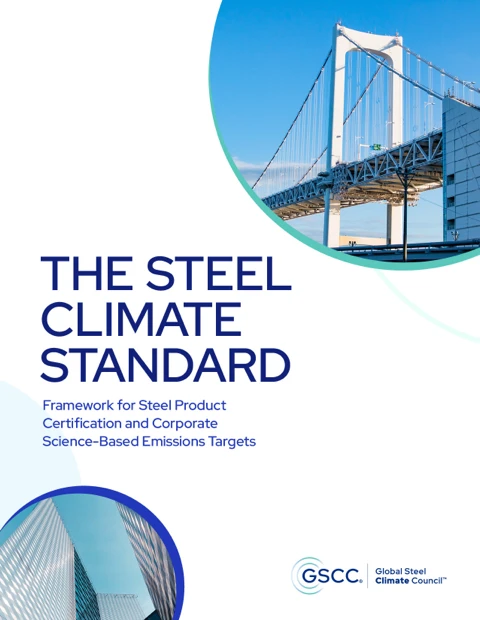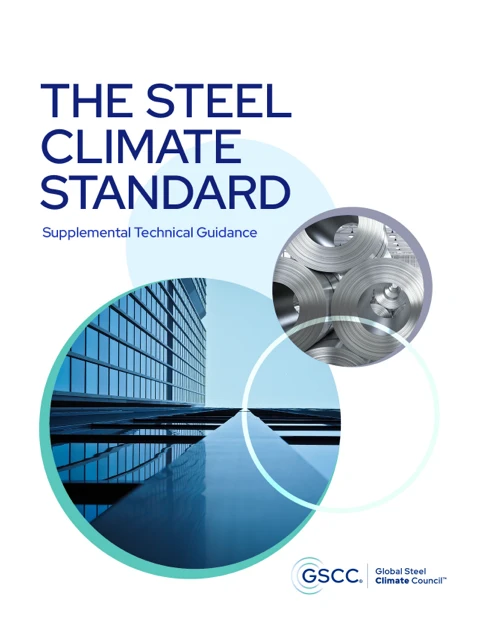
The Steel Climate Standard
The Standard measures and reports steel carbon emissions. The framework aims to reduce GHG emissions across the global steel industry, is aligned with a science-based glide path to achieve a 1.5° C scenario by 2050 and requires third-party verification of emissions data and science-based targets.
Supplemental Technical Guidance
The document provides supplemental guidance to the GSCC® Steel Climate Standard to ensure that third-party certification of steel products and science-based emission targets is implemented consistently, competently and impartially.
Our Guiding Principles
Scientific. The Steel Climate Standard relies upon extensive research and information compiled from the latest climate science, steel-industry data, and market projections from creditable sources such as the Intergovernmental Panel on Climate Change (IPCC), International Energy Agency (IEA), and World Steel Association (WSA). Our objective is to ensure that The Standard continuously aligns with the latest climate science and Paris Agreement goals to achieve sector-wide targeted reductions by 2050.
Quantitative. The Steel Climate Standard specifies numeric steel product carbon emissions intensity benchmarks, based on clearly defined boundaries that include all relevant carbon-intensive processes in the steelmaking value chain. These intensity benchmarks reduce over time to achieve the decarbonization goal for the global steel industry by 2050.
Comprehensive. The Steel Climate Standard establishes a holistic decarbonization program that includes product-based standards as well as a framework for setting science-based emissions targets for steel producers, both of which rely on the reduction of carbon emissions intensity on a carbon dioxide equivalent (CO₂e) basis, inclusive of all relevant GHGs. This product-focused approach allows for decarbonization to be practically achieved on a mill-by-mill basis, as technology evolves over the next few decades.
Principled. The Steel Climate Standard is founded on a clear vision for the future of steel in a decarbonizing economy based on a process neutral approach that holds all steel manufacturers to the same standard. This approach recognizes advances in the steel industry that have already lowered steel's embodied emissions and provides market drivers for near-term reductions as well as long-term investment in emerging technology from all producers to meet ultimate decarbonization goals.
Transparent. The Steel Climate Standard is a framework that is simple and provides a straightforward process for product certification, science-based emissions target verification, and labeling for consumer/end-market use. There is a clearly defined and comprehensive set of criteria by which progress in decarbonizing the steel sector can be measured. It relies on global standards to quality assure and verify product intensity claims.
Key Concepts
Boundary. The Steel Climate Standard defines a clear boundary for Scope 1, Scope 2, and Scope 3 sources and includes applicable GHG pollutants and covers activities from mining to hot rolling and may include contractual instruments for renewable energy and Renewable Thermal Certificates (RTCs). Emissions reductions from biogenic CO₂ and the use of process off-gases recovered for reheating and to generate electricity may be included. Carbon offsets and insets shall be excluded.
Assurance. The Steel Climate Standard protocol requires minimum data quality criteria in accordance with ISO standards for developing the carbon footprint. Within the established boundary, companies will calculate an intensity metric in units of tonnes of CO₂e per tonne of hot rolled steel (t CO₂e/t hot rolled steel). Independent third-party verification of all data in accordance with established ISO standards is required.
Product Certifications. The Steel Climate Standard provides a concise set of criteria for evaluating and certifying flat and long steel products as lower-carbon emissions steel based on their carbon intensity as determined above. Companies can certify as many or as few products as desired and can seek certification at the facility level. The product standard defines and promotes best practices for labeling of certified lower-carbon steel products to provide transparency for consumers/end-market use. Labels shall adhere to a standard format that identifies the GSCC® Steel Climate Standard (to be developed).
Science-Based Emissions Targets. The Steel Climate Standard approach champions science-based emissions targets as a key pillar of a company’s transition to a lower-carbon economy. Participating companies are required to establish and assure climate targets that are based on sound science, in alignment with the 1.5° C scenario and IEA projections for 2050, and that are then reevaluated at least every 5 years.


